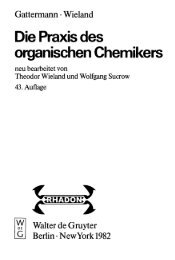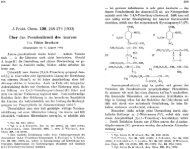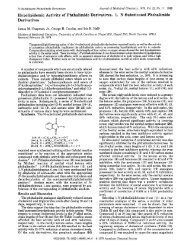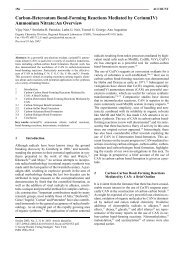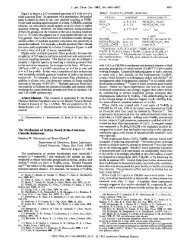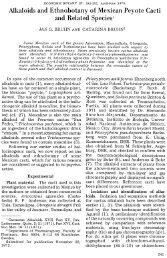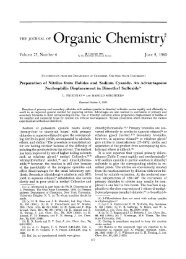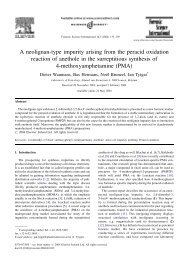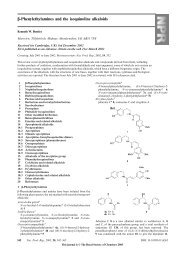Direct Titration of Epoxy Compounds and Aziridines - 1 - chemistry
Direct Titration of Epoxy Compounds and Aziridines - 1 - chemistry
Direct Titration of Epoxy Compounds and Aziridines - 1 - chemistry
You also want an ePaper? Increase the reach of your titles
YUMPU automatically turns print PDFs into web optimized ePapers that Google loves.
<strong>Direct</strong> <strong>Titration</strong> <strong>of</strong> <strong>Epoxy</strong> <strong>Compounds</strong> <strong>and</strong> <strong>Aziridines</strong><br />
SIR: The determination <strong>of</strong> the oxirane<br />
ring in organic compounds has generally<br />
involved reaction with excess hydro-<br />
chloric acid in a vayiety <strong>of</strong> solvents.<br />
Because the reaction LS slow, at least a<br />
15-minute reaction time is generally<br />
allowed before back titrating the excess<br />
acid. The determination <strong>of</strong> aziridines<br />
also requires back-titration techniques<br />
(1, 4). Durbetaki (2) described a direct<br />
titration <strong>of</strong> epoxies with anhydrous<br />
hydrogen bromide in acetic acid. While<br />
this method is rapid <strong>and</strong> capable <strong>of</strong><br />
good results, the reagent, which fumes<br />
pr<strong>of</strong>usely in air, requires special<br />
h<strong>and</strong>ling <strong>and</strong> freque it rest<strong>and</strong>ardiza-<br />
tions for accurate analyses,<br />
The following method employs a<br />
stable, readily available, titrant which<br />
can be used for the direct titration <strong>of</strong><br />
oxiranes <strong>and</strong> certain aziridines. The<br />
sample is dissolved in chlor<strong>of</strong>orm <strong>and</strong><br />
titrated to a crystal violet end point<br />
with st<strong>and</strong>ard perchloric acid (in acetic<br />
acid or dioxane) in the presence <strong>of</strong> an<br />
excess <strong>of</strong> a soluble quaternary am-<br />
monium bromide or iodide.<br />
For epoxides eithe- reagent can be<br />
used, but the quaternary bromide is<br />
satisfactory for virtually all the<br />
materials usually encountered <strong>and</strong> is<br />
recommended over the iodide because <strong>of</strong><br />
economy <strong>and</strong> better cd,orability. With<br />
aziridines, however, the iodide is pre-<br />
ferred as it gives more rapid reactions<br />
<strong>and</strong> sharper end point3.<br />
EXPERIMENTAL<br />
Reagents. St<strong>and</strong>zzd 0.1N HC104<br />
in glacial acetic acii Mix 8.5 ml.<br />
<strong>of</strong> 72y0 HClO, with 300 ml. <strong>of</strong> glacial<br />
acetic acid <strong>and</strong> add 20 ml. <strong>of</strong> acetic<br />
anhydride. Dilute to 1 liter with<br />
glacial acetic acid <strong>and</strong> allow to st<strong>and</strong><br />
overnight. St<strong>and</strong>ardize against potassium<br />
acid phthalatc: (3).<br />
Tetraethylammonium bromide reagent.<br />
Dissolve 100 grams <strong>of</strong> NEtlBr<br />
in 400 ml. <strong>of</strong> glacial aretic acid. Add a<br />
few drops <strong>of</strong> crystal violet indicator.<br />
Compensate for any slight indicator<br />
blank by titrating dropwise with the<br />
st<strong>and</strong>ard HC104 to the end point color<br />
change.<br />
Tetrabutylammoniu m iodide reagent,<br />
10% in chlor<strong>of</strong>orm. 33issolve 50 grams<br />
<strong>of</strong> NBu4I (Eastman white label grade,<br />
or equivalent) in 500 cc. <strong>of</strong> reagent<br />
grade chlor<strong>of</strong>orm. This reagent is<br />
stable providing it is riot preneutralized<br />
with perchloric acid reagent, or ex-<br />
posed to light.<br />
Store in the dark.<br />
Procedure. Into a 50-ml. Erlen-<br />
meyer flask weigh a sample estimated<br />
to contain 0.6 to 0.9 meq. <strong>of</strong> oxirane<br />
or aziridine. Dissolve in about 10<br />
ml. <strong>of</strong> chlor<strong>of</strong>orm. Acetone, benzene,<br />
<strong>and</strong> chlorobenzene may also be used<br />
as solubility considerations warrant.<br />
Add 10 ml. <strong>of</strong> the quaternary bromide<br />
or iodide reagent <strong>and</strong> 2 or 3 drops<br />
<strong>of</strong> crystal violet indicator. Titrate to<br />
a definite color change with st<strong>and</strong>ard<br />
0.1N perchloric acid using a 10-ml.<br />
micro buret. Very sharp visual end<br />
points are generally obtained, especially<br />
for epoxides, but in some cases a po-<br />
tentiometric correlation using glass us.<br />
calomel electrodes, may be desirable.<br />
The reagent blank is usually negligible,<br />
but should be checked occasionally.<br />
DISCUSSION AND RESULTS<br />
In the above titrations, hydrogen<br />
bromide (or iodide) generated in situ<br />
by the addition <strong>of</strong> perchloric acid to the<br />
quaternary ammonium halide rapidly<br />
opens the oxirane or aziridine ring<br />
CH-<br />
0’1 + HBr + -CH-CH-<br />
\I I<br />
CH-<br />
AH Br<br />
CHa<br />
-N’l + HI -c CHJ-CHa-NH-<br />
\ CJ&<br />
The large excess <strong>of</strong> bromide <strong>and</strong> the<br />
higher acid strength <strong>of</strong> perchloric acid<br />
afford somewhat more rapid oxirane<br />
titrations <strong>and</strong> sharper end points than<br />
those obtained with the HBr acetic acid<br />
titrant. -4 wide variety <strong>of</strong> epoxy com-<br />
pounds have been titrated by the<br />
tetraethylammonium bromide pro-<br />
cedure with good results. Some typical<br />
data are presented in Table I. In<br />
particular, it should be noted that<br />
epoxy resins Epon 1031 <strong>and</strong> ERRA<br />
0153 were readily analyzed by the<br />
quaternary bromide technique whereas<br />
the HBr-acetic acid method failed to<br />
give discernible end points with these<br />
solid essentially tetrafunctional resins.<br />
Work with both oxiranes <strong>and</strong><br />
aziridines demonstrated that HI is a<br />
more energetic ring opening agent than<br />
HBr <strong>and</strong> accordingly the quaternary<br />
iodide gives sharper end points in the<br />
perchloric acid titrations. With<br />
oxiranes this is <strong>of</strong> relatively little<br />
practical importance as the quaternary<br />
bromide system is adequate. However,<br />
for the aziridines, the more vigorous<br />
quaternary iodide-perchloric acid<br />
system is recommended. Likewise, for<br />
especially unreactive epoxides the iodide<br />
method is preferred, <strong>and</strong> in extraor-<br />
dinary cases an excess <strong>of</strong> perchloric<br />
acid may be added <strong>and</strong> back titrated<br />
with sodium acetate in acetic acid.<br />
The use <strong>of</strong> acetic acid as a solvent for<br />
aziridines sometimes gives low results<br />
because <strong>of</strong> a competing proton catalyzed<br />
reaction. Only a limited number <strong>of</strong><br />
aziridines have been investigated, but<br />
by using a solution <strong>of</strong> tetrabutylam-<br />
Table 1. Determination <strong>of</strong> <strong>Epoxy</strong> <strong>Compounds</strong><br />
<strong>Epoxy</strong> Equivalent Weight<br />
HC10rNEt4Br HC104-NBuJ HBr-AcOHa<br />
HC1-<br />
Dioxaneb<br />
Epon 820 (Shel1)c 190 ... 194 193<br />
Epon 828 (Shelly 188, 186, 186, 187, ... ...<br />
186, 186 186<br />
Araldite TSWR-3750 180, 181, 179, 179, ... 181, 181,<br />
(Ciba Co.) 182, 180, 179, 180 181,181<br />
<strong>Epoxy</strong> 201d (Union<br />
Carbide Chem. Co<br />
ERLB-0500’<br />
(Bakelite Co.)<br />
KP-90, Butyl epoxy<br />
stearate (Food<br />
Machinery Corp.)<br />
Butyl glycidyl ether<br />
Epon 1031 (Shell)#<br />
179<br />
152; 151,<br />
151, 151<br />
113f<br />
418. 416.<br />
417,-4i5,<br />
418, 418,<br />
417, 419,<br />
418, 419<br />
133.5. 133.6.<br />
133’. 7. 133’. 6<br />
257.2, 257.3,<br />
257.4<br />
ERRA 0153g<br />
(Bakelite Co.)<br />
260.0, 259.3<br />
Failedh<br />
5 <strong>Direct</strong> titration with HBr in AcOH (2).<br />
* Excess HC1-dioxane, back titration.<br />
Commercial epoxy resins, epichlorohydrin-bisphenol-A type.<br />
d 3,4-<strong>Epoxy</strong>-6-methylcyclohexylmethyl 3,4-epoxy-6-methylcyclohexanecsrboxylate.<br />
e p-( 2,3-<strong>Epoxy</strong>propoxy)-N,N-di-( 2,3-epoxypropyl)aniline.<br />
f Corrected for tertiary amine obtained by separate titration.<br />
0 A solid epoxy resin containing structures <strong>of</strong> the type 1,1,2,2-tetrakis(2,3-epoxypropoxypheny1)ethane.<br />
Satisfactory analysis impossible because <strong>of</strong> poor or fading end points.<br />
...<br />
134.8, 134.0,<br />
133.7, 134.4<br />
...<br />
...<br />
414, 415,<br />
414, 413,<br />
413, 415<br />
...<br />
Failedh<br />
152<br />
114<br />
420<br />
...<br />
VOL. 36, NO. 3, MARCH 1964 667
Table II. Assay <strong>of</strong> <strong>Aziridines</strong><br />
Assay, wt %<br />
NBuJ-<br />
HClOi KSCNo<br />
Tris-[ l-(a-methyl)- 97.4 97.2<br />
aziridinyllphosphine 97.8 98.1<br />
oxideb 98.1 97.1<br />
98.0<br />
Phenyl bis[l-(2- 97.9 99.0<br />
methy1)aziridinyl) 98.0 99.4<br />
phosphine oxidee 99.4<br />
Excess aqueous HC1 added in presence<br />
<strong>of</strong> excess KSCN <strong>and</strong> back titrated. A<br />
recent publication (4) describes a similar<br />
determination in methanol solution.<br />
MAPO, Interchemical Corp.<br />
c Phenyl MAPO, Interchemical Corp.<br />
monium iodide in chlor<strong>of</strong>orm the acetic<br />
acid introduced by the perchloric acid<br />
reagent did not interfere with the<br />
assays <strong>of</strong> tris- [ 1-(2-methyl)-aziridinyl]-<br />
phosphine oxide or phenyl bis [ 1-(2-<br />
methyl)aziridinyl]phosphine oxide.<br />
Some typical data are given in Table 11.<br />
For other compounds, this possible<br />
interference may dictate the sub-<br />
stitution <strong>of</strong> a perchloric acid in dioxane<br />
reagent. Even with HI, the reaction<br />
with some aziridines may be too slow<br />
to permit direct titration; in this case,<br />
excess perchloric acid may be added<br />
<strong>and</strong> back titrated potentiometrically.<br />
The fact that these methods are based<br />
upon nonaqueous acid-base titrimetry<br />
points out the nature <strong>of</strong> the interferences<br />
to be expected. Acids comparable to or<br />
weaker than acetic do not interfere.<br />
Bases will interfere unless correction<br />
is made. In many cases, potentio-<br />
metric differentiation will be possible.<br />
For aziridines, the nature <strong>of</strong> the nitrogen<br />
in the ring-opened derivative must be<br />
considered. In the case <strong>of</strong> the phos-<br />
phine oxide aziridines reported here, the<br />
resultant phosphonamide is too weakly<br />
basic to be titrated, <strong>and</strong> no interference<br />
is encountered. This will be true also<br />
for titrations <strong>of</strong> aziridinyl groups at-<br />
tached to carbonyl carbons. For other<br />
types in which the aziridine nitrogen is<br />
not influenced by a strong electrophilic<br />
function, its basic nature should be<br />
recognized.<br />
ACKNOWLEDGMENT<br />
The author acknowledges the as-<br />
sistance <strong>of</strong> Mrs. Yoshie Kadota, C. D.<br />
Shields, <strong>and</strong> other staff members in<br />
obtaining much <strong>of</strong> the data reported<br />
here.<br />
LITERATURE CITED<br />
(1) Allen, E., Seaman, W., ANAL. CHEM.<br />
27, 540 (1955).<br />
(2) . . Durbetaki, A. J., Ibid., . 28, . 2000<br />
(1956).<br />
(3) Fritz, J. S., “Acid Bye <strong>Titration</strong>s in<br />
Nonaqueous Solvents, The G. F.<br />
Smith Chemical Co., Columbus, Ohio,<br />
1952.<br />
(4) Schlitt, R. C., ANAL. CHEM. 35, 1063<br />
(1963).<br />
R. R. JAY<br />
Contribution No. 245<br />
Chemical Products Division<br />
Aerojet-General Corp.<br />
Azusa, Calif.<br />
RECEIVED for review September 20, 1963.<br />
Accepted December 30, 1963.<br />
Feed Volume Corrections in Gas Chromatography<br />
SIR: It is well known that excessive<br />
feed volume, VI, may greatly affect the<br />
performance <strong>of</strong> elution chromatographic<br />
systems. In experimental studies <strong>of</strong><br />
the factors affecting column efficiency,<br />
therefore, V, must be made so small as<br />
to have no effect on the results or some<br />
correction procedure must be applied<br />
to the data to allow for the contribution<br />
<strong>of</strong> V, to the plate height, H. So far<br />
as is known to us, tests specifically<br />
designed to ensure that the former<br />
condition applied have been conducted<br />
on only few occasions (1,7).<br />
Recently, the second approach has<br />
become common in order to overcome<br />
experimental difficulties. This note<br />
points out that an adequate correction<br />
procedure has been theoretically estab-<br />
lished only for one form <strong>of</strong> injection,<br />
that is, where the feed b<strong>and</strong> is Gaussian,<br />
<strong>and</strong> that the use <strong>of</strong> this correction<br />
procedure in general may be completely<br />
misleading. The correction procedure<br />
for a Gaussian input follows from es-<br />
tablished theory, as shown by Giddings<br />
<strong>and</strong> Robison (4). These authors, in<br />
practice, employed a short pre-column<br />
to convert the initial feed into a Gaus-<br />
sian form before injection into the study<br />
column. Then for a composite column<br />
length, L, <strong>and</strong> a pre-column length,<br />
L1, for which the st<strong>and</strong>ard deviations<br />
(u) <strong>of</strong> the emergent b<strong>and</strong>s in units <strong>of</strong><br />
time are T <strong>and</strong> T~ at retention times <strong>of</strong><br />
668 ANALYTICAL CHEMISTRY<br />
t <strong>and</strong> tl, the plate height <strong>of</strong> the study<br />
column is<br />
Provided that the pre-column pro-<br />
duces a reasonable approximation to a<br />
Gaussian peak, Equation la is valid.<br />
Later workers (3, 6) have dispensed<br />
with the pre-column <strong>and</strong> measured<br />
directly the feed volume characterized<br />
by T,, as the feed b<strong>and</strong> passed from<br />
injection system to the column head.<br />
They then employed the equation<br />
It is clear that while, with a pre-<br />
column, the conditions necessary to<br />
validate the use <strong>of</strong> Equation la may<br />
be approached in practice, it is by no<br />
means certain that Equation Ib will<br />
ever be applicable because <strong>of</strong> the dif-<br />
ficulty <strong>of</strong> producing a Gaussian b<strong>and</strong> in<br />
a simple injection system.<br />
Consideration <strong>of</strong> available experi-<br />
mental information <strong>and</strong> the sequence <strong>of</strong><br />
events in conventional injection sys-<br />
tems, in fact, suggests that, normally,<br />
the injection pr<strong>of</strong>ile approximates more<br />
closely a square wave (plug injection)<br />
pr<strong>of</strong>ile than a Gaussian shape. Further,<br />
the applicability <strong>of</strong> the feed volume<br />
equation<br />
2v ’<br />
v, Q 2<br />
div<br />
which may be rigorously derived (8)<br />
from the Glueckauf square wave in-<br />
jection model (@, is widely accepted<br />
<strong>and</strong> has several times been directly<br />
tested (I, W,7).<br />
The equality expressed in Equation 2<br />
represents the upper limit <strong>of</strong> feed<br />
volume which still allows computation<br />
<strong>of</strong> the number <strong>of</strong> theoretical plates, N,<br />
via the equation<br />
(3)<br />
where Vs’ is the total retention volume<br />
(or time), u is the st<strong>and</strong>ard deviation<br />
in appropriate units, <strong>and</strong> p <strong>and</strong> W have<br />
their usual meaning. If the inequality<br />
is satisfied, in fact, the number <strong>of</strong> plates<br />
calculated from experimental data,<br />
N’, is related to the true number, N,<br />
by<br />
N’ = N - (N,/2)<br />
(4)<br />
where N, is the number <strong>of</strong> plates taken<br />
up by the feed b<strong>and</strong>. This equation<br />
does not represent a correction. In<br />
any case, the triviality <strong>of</strong> (N,/2) in<br />
these circumstances can readily be<br />
demonstrated. For the maximum value<br />
<strong>of</strong> V, allowed by Equation 2, it can




